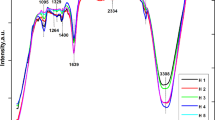Abstract
In order to improve biocompatibility and cell growth, poly-γ-glutamic acid (γ-PGA) was used as an additive, and a series of γ-PGA/hydroxyapatite (γ-PGA/HAp) nanocomposites were prepared. Then the morphology, water uptake and retention abilities, in vitro degradation properties in the simulated medium, and cytotoxicity of these γ-PGA/HAp nanocomposites were investigated. The results show that the γ-PGA/HAp nanocomposites have homogenous nano-sized grains, hydrophilicity, biocompatibility, and controlled in vitro degradation, suggesting that the γ-PGA/HAp nanocomposites are novel nanostructure composites with great potential application in the field of bone tissue engineering.







Similar content being viewed by others
References
Cole W, Ginn TA, Chen GJ et al (2005) Cost comparison of anterior cruciate ligament reconstruction: autograft versus allograft. Arthroscopy 21:79–786
Giannoudis DP, Dinopoulos H, Tsiridi E (2005) Bone substitutes: an update. Injury 36:20–27
Shih IL, Van VT (2001) The production of poly-(γ-glutamic acid) from microorganisms and its various applications. Bioresour Technol 79:207–225
Guo ST, Huang YY, Zhang WD et al (2011) Ternary complexes of amphiphilic polycaprolactone-graft-poly(N,N-dimethylaminoethyl methacrylate), DNA and polyglutamic acid-graft-poly(ethylene glycol) for gene delivery. Biomaterials 32:4283–4292
Mohandes F, Salavati-Niasari M (2014) Particle size and shape modification of hydroxyapatite nanostructures synthesized via a complexing agent-assisted route. Mater Sci Eng C 40:288–298
Armentano I, Dottori M, Fortunati E et al (2010) Biodegradable polymer matrix nanocomposites for tissue engineering: a review. Polym Degrad Stabil 95:2126–2146
Hu Q, Li B, Wang M, Shen J (2004) Preparation and characterization of biodegradable chitosan/hydroxyapatite nanocomposite rods via in situ hybridization: a potential material as internal fixation of bone fracture. Biomaterials 25(5):779–785
Thein-Han WW, Misra RDK (2009) Biomimetic chitosan–nanohydroxyapatite composite scaffolds for bone tissue engineering. Acta Biomater 5:1182–1197
Jiang LY, Li YB, Xiong CD (2009) A novel composite membrane of chitosan–carboxymethyl cellulose polyelectrolyte complex membrane filled with nano-hydroxyapatite I. Preparation and properties. J Mater Sci Mater Med 20:1645–1652
Dorozhkin S (2010) Bioceramics of calcium orthophosphates. Biomaterials 31:1465–1485
Dorozhkin S (2010) Amorphous calcium (ortho) phosphates. Acta Biomater 6:4457–4475
Freed LE, Vunjak-novakovic G, Biron RJ (1994) Biodegradable polymer scaffolds for tissue engineering. Biotechnology (NY) 12:6892
Wang CF, Min Feng M, Deng JJ et al (2010) Poly(α-glutamic acid) combined with polycation as serum-resistant carriers for gene delivery. Int J Pharm 398:237–245
Kubota H, Matsunobu T, Uotani K et al (1993) Production of poly(γ-glutamic acid) by Bacillus subtilis F-2-01. Biosci Biotech Agroch 57:1212–1213
Kunioka M, Goto A (1994) Biosynthesis of poly(γ-glutamic acid) from l-glutamic acid, citric acid and ammonium sulfate in Bacillus subtilis IFO3335. Appl Microbiol Biotechnol 40:867–872
Kurosaki T, Kitahara T, Kawakami S et al (2010) γ-Polyglutamic acid-coated vectors for effective and safe gene therapy. J Control Release 142:404–410
Tripathi SK, Goyal R, Ansari KM et al (2011) Polyglutamic acid-based nanocomposites as efficient non-viral gene carriers in vitro and in vivo. Eur J Pharm Biopharm 79:473–484
Hsieh CY, Tsaia SP, Wang DM et al (2005) Preparation of γ-PGA/chitosan composite tissue engineering matrices. Biomaterials 26:5617–5623
Chang KY, Cheng LW, Ho GH et al (2009) Fabrication and characterization of poly(gamma-glutamic acid)-graft-chondroitin sulfate/polycaprolactone porous scaffolds for cartilage tissue engineering. Acta Biomater 5:1937–1947
Kim MM, Seo M, Chung JW et al (2009) Polymeric calcium phosphate cements incorporated with poly-γ-glutamic acid: comparative study of poly-γ-glutamic acid and citric acid. J Appl Polym Sci 113:1223–1231
Ledezma-Pérez AS, Romero-Garcia J, Vargas-Gutierrez G et al (2005) Cement formation by microbial poly(γ-glutamic acid) and fluoro-alumino-silicate glass. Mater Lett 59:3188–3319
Hellmers F, Ferguson P, Koropatnick J et al (2013) Characterization and in vitro cytotoxicity of doxorubicin-loaded γ-polyglutamic acid–chitosan composite nanoparticles. Biochem Eng J 75:72–78
Hoennscheidt C, Kreyenschulte D, Margaritis A et al (2013) Production of stable quinine nanodispersions using esterified γ-polyglutamic acid biopolymer. Biochem Eng J 79:259–266
Mi HY, Jing X, Salick MR et al (2014) Morphology, mechanical properties, and mineralization of rigid thermoplastic polyurethane/hydroxyapatite scaffolds for bone tissue applications: effects of fabrication approaches and hydroxyapatite size. J Mater Sci 49:2324. doi:10.1007/s10853-013-7931-3
Acknowledgements
This work is financially supported by the Science and Technology Planning Project of Guangdong Province (No. 2012B010200044) and the Guangzhou Science and Technology Planning Project (No. 11C14060684). We also would like to thank Mrs. Ai-lin Zhang and her team for their assistances in SEM and TEM.
Author information
Authors and Affiliations
Corresponding author
Rights and permissions
About this article
Cite this article
Shu, X., Shi, Q., Feng, J. et al. Design and in vitro evaluation of novel γ-PGA/hydroxyapatite nanocomposites for bone tissue engineering. J Mater Sci 49, 7742–7749 (2014). https://doi.org/10.1007/s10853-014-8484-9
Received:
Accepted:
Published:
Issue Date:
DOI: https://doi.org/10.1007/s10853-014-8484-9




